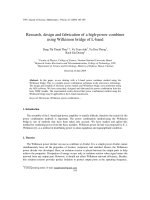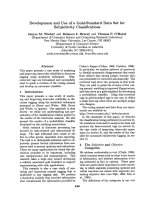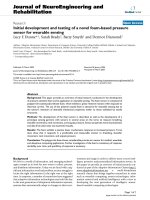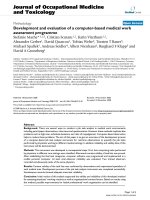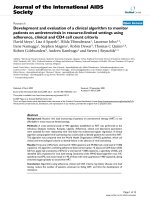Development and fabrication of a tunable high frequency, high voltage power supply for atmospheric pressure plasma jet generation
Bạn đang xem bản rút gọn của tài liệu. Xem và tải ngay bản đầy đủ của tài liệu tại đây (1.27 MB, 9 trang )
Research
DEVELOPMENT AND FABRICATION OF A TUNABLE HIGH
FREQUENCY, HIGH VOLTAGE POWER SUPPLY FOR
ATMOSPHERIC-PRESSURE PLASMA JET GENERATION
Le Thi Quynh Xuan1, Nguyen Nhat Linh1,2, Dao Nguyen Thuan1,*
Abstract: More recently, the innovative non-thermal plasma (NTP) technology
has drawn considerable attention in various fields, from applied research to
industry. In this work, we have developed and successfully fabricated a high
frequency (30-70 KHz), high voltage generator (2-6 kV) as a power supply to
generate a plasma jet. Effect of the oscillating frequency, the applied voltage on the
output voltage and the plasma jet’s stability were studied. A stable plasma jet with a
maximum length of 1.5-1.8 cm could be achieved at output voltage ~ 6 kV and
oscillating frequency ~ 55 KHz. We showed that this plasma jet system could be
applied as a quick, chemical-free and effective method to enhance seed germination
and seedling growth of black turtle bean.
Keywords: Cold plasma; Plasma jet; Dielectric Barrier Discharge; High voltage; High frequency; Push-pull
circuit.
1. INTRODUCTION
Non-thermal plasma (NTP) or cold plasma is an ionized gas at non-thermal
equilibrium while the temperature of ions and gas (~300K) is much lower than
electron’s temperature (>104K). Cold plasma caries charged particles (electrons,
ions), radicals (reactive oxygen species - ROS, reactive nitrogen species - RNS)
and irradiated UV which strongly interacts and have effects on many objects. In
recent decades, cold plasma have been studied extensively and is widely applied in
various fields from research to industry including material science (surface
modification and functionalizing (1)), agriculture (killing virus/bacterial (2),
enhancing seed germination and seedling growth (3,4)…), medicine (sterilization
(5), wound healing (6), plastic surgery (7)…), environment (water treatment (8),
waste treatment…), and food safety (decontamination (9)).
In recent years, several devices have been presented that are able to generate a
cold plasma plume at atmospheric pressure in air. They employs different methods
using microwaves, radio frequency, pulsed or alternative current in various setups
such as dielectric barrier discharge (DBD), atmospheric pressure plasma jet
(APPJ), and corona discharges. All of these discharges have their own unique
features. In this work, we aim to develop an atmospheric pressure plasma jet
(APPJ) system. This configuration has an advantage that there will be a dielectric
barrier (quartz tube) between the plasma emitting electrode and the outer electrode,
hence minimizing risk of sparks and arcs between theses electrodes.
In order to build a plasma jet system, we need to develop and fabricate a
tunable high frequency, high voltage (~ few kV) power supply to generate the
plasma jet. Typical high voltage DC (direct current) power supply are availed
commercialized, however, it is not suitable for plasma jet generation. The charge
on the 2 electrodes need to be altered in order for the plasma jet to operate. It is
important to emphasize that the electrodes will be eroded overtime when the
discharge is continuous (with a low frequency high voltage power supply). This
Journal of Military Science and Technology, Special Issue, No.57A, 11 - 2018
79
Physics
leads to the instability of the plasma discharge. Therefore, by using a high voltage,
high frequency power source, the two electrodes are constantly changing their
charge very fast (high frequency) which will help to minimize eroding effect
significantly, hence allowing stable and long operation of the plasma system.
2. MATERIALS AND METHODS
2.1. Development of a tunable high frequency, high voltage power supply
The tunable high frequency, high voltage power supply consisted of 4 main
units: a power unit, a duty-cycle PWM controller, a PWM high frequency
generator and a high voltage transformer (Figure 1 and 2). The function of each
unit was as the following:
The power unit (8-14V) supplied a stable power for the system.
The duty-cycle controller unit using an IC NE555 to generate pulses to
control the operation of the following high frequency generator unit. The
duty-cycle controller unit also allowed the system to run steadily at the
upper range of the output voltage (~6 kV) while limiting the circuit’s
current, hence avoiding overheat on electrical components, especially on
the MOSFET transistors.
The
rate
of
the
duty-cycle
controller
was
defined
as
f = 1⁄ ln2. C . (R + 2R )
Duty cycle ON duration (state 1) in one cycle t = ln2. C . (R + R )
Duty cycle OFF duration (state 0) in one cycle t = ln2. C . R
The high frequency generator unit used a PWM IC SG3525 to generate 2
reverse tunable high frequency pulses in order to operate 2 MOSFET
IRFP250 transistors in push-pull configuration. This block generated a high
frequency square voltage (few hundred V) to feed in the input of the
following high voltage transformer unit.
The high frequency output signal at pin 11 and 14 could be defined as:
1
C + (0.7. R + 3R )
The high voltage transformer unit was employed to amplify the input voltage
(a few hundred V) to very high output voltage (~ 2-6 kV). This high voltage
transformer was made of ferrite core with (5+5) turns on the primary winding
and 3000 turns on the secondary winding. The core and windings were
immersed in electrical insulating oil to prevent any electrical sparks and arcs.
f=
Figure 1. Diagram of 4 main component units of the tunable high frequency,
high voltage power supply.
80
L. T. Q. Xuan, N. N. Linh, D. N. Thuan, “Development and … plasma jet generation.”
Research
Figure 2. Circuit diagram of the duty-cycle control unit, the high frequency
generator unit and the high voltage transfomer unit.
Although some reports on high voltage, high frequency power supply using a
phase-shifted PWM full bridge inverter (10), or a parallel-resonant push-pull
inverter (11), or an input-series two-transistor flyback (12) were described
elsewhere. Our circuit had an advantage that allowed tuning various parameters as
the applied voltage, the high frequency, and the duty cycle independently. The
optimization of our circuit also minimized heat loss on most power-consumed ICs,
hence allowed the circuit to work for very long operation time without overheating
on the MOSFET transistors as well as the high voltage transfomer.
2.2. Configuration and fabrication of a plasma jet emitter
The plasma jet emitter consisted of a stainless steel syringe inserted inside a
quartz capillary tube of 1.5mm internal diameter following a set up as reported
(13). The needle was shortened and covered with an insulating rubber, then
attached to a quartz tube by adhesive epoxy. Copper electrode outside the quartz
tube was made by wrapping a copper tape around the tube. Various quartz tubes
with different internal diameters and metal needle with different diameters were
tested. Generally, with smaller and shorter needles, the plasm jet beams were
longer. However, if the needle was small, the jet beam had a small cross section,
which was difficult to use in many applications. In our setup, the tube length was 4
cm while the needle length was 3cm. This configuration gave the jet beam with a
maximum length of 1.5-1.8 cm and was highly stable.
2.3. Characterization of the plasma jet system
A Tektronix P6015 Voltage Probe (1000:1) connected to a Tektronix TBS1154
oscilloscope to measure output voltage of our power supply. The output voltage
was varied between 2 kV and 6kV to study its impact to the plasma jet. The Argon
gas was connected to a flow controller to vary the gas flow rate conditions, from
200 sccm to 900 sccm. The optical emission of the plasma jet discharge in 3001000 nm range was collected at 10 mm away from the nozzle and focused on the
input of an IHR550 spectrometer (Figure 3).
Journal of Military Science and Technology, Special Issue, No.57A, 11 - 2018
81
Physics
Figure 3. Setup for electrical and optical characterization of the plasma jet system.
3. RESULTS AND DISSCUSION
3.1. Plasma jet’s operating condition
condition:: Minimum voltage for electrical discharge
To create a plasma jet, it is necessary to have an electr
electrical
ical discharge between
the two electrodes inside the quartz tube. The minimum breakdown voltage
required to initiate electrostatic discharge between two electrodes is determined by
Paschen's law.
with VB is the breakdown voltage [V]; p is the pressure [[pascal];
pascal]; d is
is the distance
between two electrodes [m]; γse is
is the secondary
secondary--electron
electron
electron--emission
emission coefficient (the
number of secondary electrons produced per incident positive ion), A, B are
constant coefficient depends on gas type.
With Ar gas, at p = 2.0 [Torr],
[Torr], the minimun breakdown voltage is 215 [V] at pd
= 0.7 [Torr.cm] (14)
(14).. The distance between the metal tip and copper ring in our
setup is 0.5 cm.
m. With this distance, the minimum potential for a breakdown
discharge in Ar gas is VB ~ 2 [kV]. However, it should be noted that as one of the
two electrodes is a sharp electrode, the minimum voltage for a breakdown
discharge is lower because the charge density at the tip is higher. When applying a
high-voltage
highvoltage high
high--frequency
frequency voltage on the metal syringe and copper electrode,
and with Ar gas flow, it will produce a plasma jet (15).
(15)
3.2. Effect of the oscillating frequency on the output voltage and stability
In order to determine the optimal operating frequency of the plasma jet system,
we varied the oscillating frequency of the power supply from 30 KHz to 70 KHz
(Figure 4). The error bar at each monitoring frequency was determined by the
82
L. T. Q. Xuan, N. N. Linh, D. N. Thuan, “Develop
Development and … plasma jet generation
Development
generation.”
”
Research
difference of output voltage between loaded (plasma emission) and unloaded (no
plasma emission) operating condition. Figure 3 showed that maximum output
voltage can be achieved by our power supply is ~ 6 kV at oscillating frequency f ~
voltage
50 KHz. The balanced sinusoidal output voltage represented the stability of the
power supply and the high frequency transformer when operating in push
push-pull
pull
mode (Figure 5). In lloaded
oaded condition, the jet beam reached a maximum length of
1.8 cm and the plasma jet was stable at this condition.
Figure 4. Dependence of output voltage Vpp vs. oscillating frequency
of the power supply.
Figure 55. Characterization of output voltage waveform from our power supply.
3.3. Effect of the applied voltage on the output voltage and the maximum
3.3
current
Table 1 showed the dependence of high output voltage and current when
changing the input voltage from 8V to 114V
4V (the oscillation frequency was 556.4
6.4
kHz). With maximum current varying from 1 to 2 (A), the circuit was stable and
the heat loss was low (the 2 IRF250 MOSFET transistors were not overheated).
The output voltage could vary between 2 - 6 kV when changing the input in the
range of 8 - 14 V.
Journal of Military Science and Technology, Special Issue, No
No.57A
.57A, 11 - 2018
2018
83
Physics
Table 1. Dependence of the output voltage and the maximum current vs. the input
voltage when the power supply operated at 54.6 KHz.
Input Voltage Vin
(V)
8
9
10
11
12
13
14
Output Voltage Vpp
(kV)
2.1
2.8
3.3
3.9
4.5
5.3
6.1
Imax (A)
0.96
1.12
1.32
1.45
1.54
1.68
1.78
3.4. Emission spectra of the plasma jet
Figure 6 was the optical emission spectrum (OES) of the plasma jet ranging
from 300 to 1000 nm. There were 3 spectral regions: the 700-900 nm spectral
region was due to the electron displacement of 2pi to 1si of the Ar atom. In the
vicinity of ultraviolet light at 300-400 nm were the emission lines of the N2 atom.
Under the plasma arc discharge, water molecules inside the quartz tube were
irradiated into OH- radicals and contributed an emission band around 300 nm. An
analysis of gas flow rate ranging from 200 sccm to 900 sccm showed that our
system could generate stable plasma jet, with the full spectra of OH- and N2
characteristic peaks. The plasma temperature measured by a digital thermometer at
the end of the quartz tube was 25 - 29 °C, which was suitable to be applied in
various life science researches.
Figure 6. Emission spectra of the plasma jet in 300 - 1000 nm range.
3.5. Application of the atmospheric-pressure plasma jet in agriculture: an
example of enhancing seed germination and seedling growth of black turtle bean
The effects of cold plasma (CP) treatment on seed germination of black turtle
bean was investigated. The seeds were pre-selected to ensure germination
capability and had similar size and shape (Figure 7-A). Seed germination and
seedling root were significantly enhanced after only 2-minutes plasma treatment
(Figure 7-B). The mechanism of this enhancement could be 2 folds. First, the
84
L. T. Q. Xuan, N. N. Linh, D. N. Thuan, “Development and … plasma jet generation.”
Research
plasmas directly induced changes in the seed coating, which could lead to better
water absorption on the surface of treated seeds (16). Second, other works
suggested oxygen and nitrogen reactive species (RONS) and radicals could
penetrate into the seed and enhanced the metabolic process of plant growth (3,4).
TOF-SIMS (Time-of-Flight Secondary Ion Mass Spectrometry) spectroscopy
shown a significant increase in the concentration of oxygen- and nitrogencontaining groups on the surface of the plasma treated lentil, beans and wheat
seeds (17). Our results showed that cold plasma treatment could be used as a quick
and effective method to enhance seed germination and seedling growth of black
turtle bean. This method could be applied to various vegetable’s seeds.
Figure 7. Effect of cold plasma treatment time on seeds’ germination and
seedling growth of black turtle bean. (A) Cold plasma treatment on black turtle
bean. (B) Photo of batches of 10 black turtle bean seeds after 24 hours sowing on
paper on a petri dish with no plasma treatment (left) and with 2-minutes plasma
treatment (right).
4. CONCLUSION
We have developed and successfully fabricated a high frequency (30-70 KHz)
high voltage generator (2-6 kV) as a power supply for a plasma jet system. Effect
of the oscillating frequency, the applied voltage on the output voltage and the
plasma jet’s stability were studied. A stable plasma jet with a maximum length of
1.5-1.8 cm could be achieved at output voltage ~ 6kV and oscillating frequency ~
55 KHz. The plasma jet operated steadily at room temperature and atmospheric
pressure could be used for agricultural and biological applications. We have
demonstrated an application of this plasma jet system as a quick, chemical-free
and effective method to enhance seed germination and seedling growth of black
turtle bean.
Acknowledgement: This research was supported by IMS, VAST under grant
number CSCL04.18.
REFERENCES
[1]. Reichen, P., Sonnenfeld, A. and Rudolf von Rohr, P. (2009) "Remote Plasma
Device for Surface Modification at Atmospheric Pressure". Plasma Processes
and Polymers, Vol. 6, pp. S382-S386.
Journal of Military Science and Technology, Special Issue, No.57A, 11 - 2018
85
Physics
[2]. Liu, F., Sun, P., Bai, N., Tian, Y., Zhou, H., Wei, S., Zhou, Y., Zhang, J., Zhu,
W., Becker, K. et al. (2010) "Inactivation of Bacteria in an Aqueous
Environment by a Direct-Current, Cold-Atmospheric-Pressure Air Plasma
Microjet". Plasma Processes and Polymers, Vol. 7, pp. 231-236.
[3]. Ji, S.-H., Choi, K.-H., Pengkit, A., Im, J.S., Kim, J.S., Kim, Y.H., Park, Y.,
Hong, E.J., Jung, S.k., Choi, E.-H. et al. (2016) "Effects of high voltage
nanosecond pulsed plasma and micro DBD plasma on seed germination,
growth development and physiological activities in spinach". Arch. Biochem.
Biophys., Vol. 605, pp. 117-128.
[4]. Bafoil, M., Jemmat, A., Martinez, Y., Merbahi, N., Eichwald, O., Dunand, C.
and Yousfi, M. (2018) "Effects of low temperature plasmas and plasma
activated waters on Arabidopsis thaliana germination and growth". PLOS
ONE, Vol. 13, pp. e0195512.
[5]. Laroussi, M. (2005) "Low Temperature Plasma-Based Sterilization: Overview
and State-of-the-Art". Plasma Processes and Polymers, Vol. 2, pp. 391-400.
[6]. Isbary, G., Stolz, W., Shimizu, T., Monetti, R., Bunk, W., Schmidt, H.U.,
Morfill, G.E., Klämpfl, T.G., Steffes, B., Thomas, H.M. et al. (2013) "Cold
atmospheric argon plasma treatment may accelerate wound healing in
chronic wounds: Results of an open retrospective randomized controlled
study in vivo". Clinical Plasma Medicine, Vol. 1, pp. 25-30.
[7]. von Woedtke, T., Metelmann, H.R. and Weltmann, K.D. (2014) "Clinical
Plasma Medicine: State and Perspectives of in Vivo Application of Cold
Atmospheric Plasma". Contributions to Plasma Physics, Vol. 54, pp. 104-117.
[8]. Samanta, K.K., Jassal, M. and Agrawal, A.K. (2009) "Improvement in water
and oil absorbency of textile substrate by atmospheric pressure cold plasma
treatment". Surf. Coat. Technol., Vol. 203, pp. 1336-1342.
[9]. Pankaj, S.K., Bueno-Ferrer, C., Misra, N.N., Milosavljević, V., O'Donnell,
C.P., Bourke, P., Keener, K.M. and Cullen, P.J. (2014) "Applications of cold
plasma technology in food packaging". Trends in Food Science & Tech., Vol.
35, pp. 5-17.
[10]. Hothongkham, P. and Kinnares, V. (2010), The 2010 International Power
Electronics Conference - ECCE ASIA -, pp. 1560-1567.
[11]. Alonso, J.M., Garcia, J., Calleja, A.J., Ribas, J. and Cardesin, J. (2005)
"Analysis, design, and experimentation of a high-voltage power supply for
ozone generation based on current-fed parallel-resonant push-pull inverter".
IEEE Transactions on Industry Applications, Vol. 41, pp. 1364-1372.
[12]. Meng, T., Song, Y., Wang, Z., Ben, H. and Li, C. (2018) "Investigation and
Implementation of an Input-Series Auxiliary Power Supply Scheme for HighInput-Voltage Low-Power Applications". IEEE Transactions on Power
Electronics, Vol. 33, pp. 437-447.
[13]. Hong, Y., Lu, N., Pan, J., Li, J., Wu, Y. and Shang, K. (2013) "Electrical and
Spectral Characteristics of a Low-Temperature Argon–Oxygen Plasma Jet
With Syringe Needle-Ring Electrodes". IEEE Transactions on Plasma
Science, Vol. 41, pp. 545-552.
86
L. T. Q. Xuan, N. N. Linh, D. N. Thuan, “Development and … plasma jet generation.”
Research
[14]. Torres, C., Reyes, P.G., Castillo, F. and Martínez, H. (2012) "Paschen law
for argon glow discharge". Journal of Physics: Conference Series, Vol. 370,
pp. 012067.
[15]. Muyang, Q., Congying, Y., Sanqiu, L., Xiaochang, C., Gengsong, N. and
Dezhen, W. (2016) "Gas flow dependence of atmospheric pressure plasma
needle discharge characteristics". Japanese Journal of Applied Physics, Vol.
55, pp. 046101.
[16].Zhou, R., Zhou, R., Zhang, X., Zhuang, J., Yang, S., Bazaka, K. and Ostrikov,
K. (2016) "Effects of Atmospheric-Pressure N2, He, Air, and O2
Microplasmas on Mung Bean Seed Germination and Seedling Growth". Sci
Rep-Uk, Vol. 6, pp. 32603.
[17]. Bormashenko, E., Grynyov, R., Bormashenko, Y. and Drori, E. (2012) "Cold
radiofrequency plasma treatment modifies wettability and germination speed
of plant seeds". Sci Rep-Uk, Vol. 2, pp. 741-741.
TÓM TẮT
NGHIÊN CỨU PHÁT TRIỂN VÀ CHẾ TẠO BỘ NGUỒN CAO ÁP TẦN SỐ
CAO SỬ DỤNG LÀM NGUỒN PHÁT PLASMA JET Ở ÁP SUẤT KHÍ QUYỂN
Gần đây, công nghệ plama nhiệt độ thấp nhận được nhiều quan tâm nghiên cứu
và được phát triển mạnh mẽ để ứng dụng trong nhiều lĩnh vực, từ nghiên cứu cơ bản
đến các lĩnh vực nông nghiệp, y tế, môi trường… Trong nghiên cứu này, chúng tôi
đã phát triển và chế tạo được bộ phát cao áp (2-6 kV) tần số cao (30-70 Khz) làm
nguồn cho thiết bị phát plasma jet. Ảnh hưởng tần số dao động, điện áp đầu vào tới
cao áp đầu ra và độ ổn định của tia plasma đã được khảo sát. Kết quả cho thấy tia
plasma jet có thể đạt chiều dài ổn định tối đa là 1.5-1.8 cm với điện áp đầu ra là ~ 6
kV và tần số dao động ~ 55 KHz. Hệ plasma jet chế tạo được đã được sử dụng để
kích thích hạt đỗ đen nảy mầm và phát triển một cách nhanh chóng, hiệu quả mà
không cần sử dụng hóa chất nào.
Từ khóa: Plasma lạnh; Plasma dạng tia; Phóng điện qua hàng rào điện môi; Cao áp; Tần số cao; Mạch đẩy kéo.
Received 8th September 2018
Revised 20 th October 2018
Accepted 1st November 2018
Author affiliations:
1
Institute of Materials Sciences (IMS), VAST;
2
Plasma Bioscience Research Center, Kwangwoon University, South Korea.
*Corresponding author:
Journal of Military Science and Technology, Special Issue, No.57A, 11 - 2018
87

